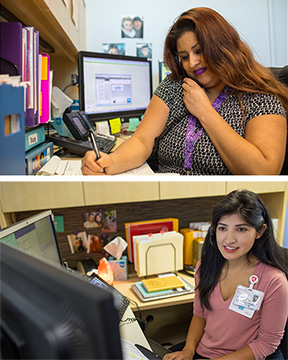Developmental-Behavioral Pediatrics services at Stanford goes to Remote Telehealth for all visits in the COVID-19 Pandemic
April 24, 2020

|
The Covid-19 pandemic demanded quick decisions and many changes. Our county was an early hot spot. So, we needed to get to work early in the game. Our DBP team, in consultation with a receptive hospital administration, rapidly determined that we should not bring infants and toddlers from the High-Risk Infant Follow-Up program to the clinic because of their increased vulnerability to infection. However, we did not want to cancel visits, especially at a time of high stress when children may be at risk for other dangers, such as maltreatment or hunger.
Beginning March 9, we decided to do all visits via telehealth. We included all children, including preschoolers and school-aged children to reduce their possible exposure. The clinicians went to clinic where they logged on for telehealth visits. Families remained at home. We continued to teach the fellows and residents on service; they sat beside us.
Beginning on March 17, Governor Newsome gave the order to shelter-in-place. We rapidly converted to remote telehealth. Our clinicians stayed at home and connected to children and families versus a secure portal in one of four ways: the electronic health record, zoom, webex, or telephone. We then figured out how to engage fellows and residents in visits with the help of IT at the hospital, using combinations of the virtual telehealth room and zoom, or zoom only. Physicians, psychologists, and nurses have all participated in remote telehealth.
Here is what we have learned.
- Families are very appreciative for the telehealth visits.
- Our office staff calls ahead, assures that families know how to log on and connect, so the proportion of successful visits is high.
- We learn a lot about families by observing the adult and child or children in their natural environment.
- We have been able to complete a full evaluation under selected circumstances, particularly when families were seeking a second opinion or a medical diagnosis to complement a school evaluation. We have been using questionnaires and surveys to gain information about neuropsychological or psychoeducational functioning.
- We will need to evaluate many children in a subsequent face-to-face visit. However, we will reduce the amount of time for the future scheduled visit because we have a comprehensive history. In many cases, we have established a differential diagnosis, sent the family materials to read so that they can participate knowledgably in the subsequent visit, and discussed specifically what the plan is going forward.
- We will be considering how to continue to use telehealth productively in our clinical practice, even beyond this period of national crisis
The team of clinicians and staff has been amazing: cheerful, resourceful, flexible, and committed. Thank you to all of my colleagues.
For materials for professionals and families, visit: dbpeds.stanford.edu.







